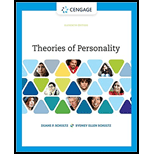
To explain:
The ways in which Alder’s own childhood history gets reflected.
Introduction:
Alder has experienced with lot of illness at his childhood which made feel jealous with Freud and inferior to him physically and this experience helped him to develop a theory at his later age giving importance to the role of inferiority and birth order.
Explanation of Solution
Alder formulated a theory on base that inferiority is a feeling possessed by everyone right from birth due to the dependence experienced by them at each stage and they strive for superiority. Alder experienced inferiority at this childhood due to his physical illness. He also had a jealous feeling at his brother when he sees him healthy and playing and he took it in a positive way and strived for superiority by showing excellence at academics. Based on birth order also he formulated that middle child will always try to beat first child, competitive which is same thing he experienced at his childhood, when it comes to Freud (his elder brother). Adler, when he was under Freud, he believes lust for power, need for dominance lies as a drive force, once he got recognition for his own work, he believes apart from needs social interest lie as a major driving force.
His theory cannot be measured and less scientific are short comings of his theory. Apart from this his childhood experience played a major role of outcome of his formulation of theory. The attention he got from his mother also got reduced after the arrival of next new born baby and that also has its influence in his theory of personality.
Want to see more full solutions like this?
Chapter 4 Solutions
THEORIES OF PERSONALITY (LL)
- Describe the four characteristics of generalist practice. Select one of the characteristics and provide an example of how you see yourself implementing that characteristic in the field. How will this implementation affect the client? Please cite in text source and list references. This discussion question provides specific content that will assist in preparing for the ASWB licensing exam.arrow_forwardProfessional Development: What does it mean to you to be a social work professional? How does the NASW Code of Ethics relate to how you act as a professional? Please cite in text source and list references.arrow_forwardExplain how social work is different from other helping professions and why, providing at least three examples. Explain how you can partner with other helping professionals throughout your career in the field. Describe the development of social work as a profession. Please cite in text source and list referencesarrow_forward
- Can you give me a summary of these two videos Gandhi: the road to freedom (2009) https://www.youtube.com/watch?v=boPkMCJSYSsarrow_forwardWhat are the 3 key ideas described in the Video: EcoSense for Living, Future Food https://www.pbs.org/video/future-food-rcje6j/arrow_forwardWhat would be a good description of health for an individual today? How does gender, culture and the practice of health infulence your description?arrow_forward
- Write a love poem about someone longing for a sandwich. Make it a sonnet, and give it a tone that straddles a serious love poem and whimsy appropriate for a poem about a sandwich.arrow_forwardI need help finding 16 pop psychology self-help tyoe book on dating& relationshiparrow_forwardCan you make good 12 discussion questions when it comes to attraction to tattoos an to non tatoosarrow_forward
 Ciccarelli: Psychology_5 (5th Edition)PsychologyISBN:9780134477961Author:Saundra K. Ciccarelli, J. Noland WhitePublisher:PEARSON
Ciccarelli: Psychology_5 (5th Edition)PsychologyISBN:9780134477961Author:Saundra K. Ciccarelli, J. Noland WhitePublisher:PEARSON Cognitive PsychologyPsychologyISBN:9781337408271Author:Goldstein, E. Bruce.Publisher:Cengage Learning,
Cognitive PsychologyPsychologyISBN:9781337408271Author:Goldstein, E. Bruce.Publisher:Cengage Learning, Introduction to Psychology: Gateways to Mind and ...PsychologyISBN:9781337565691Author:Dennis Coon, John O. Mitterer, Tanya S. MartiniPublisher:Cengage Learning
Introduction to Psychology: Gateways to Mind and ...PsychologyISBN:9781337565691Author:Dennis Coon, John O. Mitterer, Tanya S. MartiniPublisher:Cengage Learning Psychology in Your Life (Second Edition)PsychologyISBN:9780393265156Author:Sarah Grison, Michael GazzanigaPublisher:W. W. Norton & Company
Psychology in Your Life (Second Edition)PsychologyISBN:9780393265156Author:Sarah Grison, Michael GazzanigaPublisher:W. W. Norton & Company Cognitive Psychology: Connecting Mind, Research a...PsychologyISBN:9781285763880Author:E. Bruce GoldsteinPublisher:Cengage Learning
Cognitive Psychology: Connecting Mind, Research a...PsychologyISBN:9781285763880Author:E. Bruce GoldsteinPublisher:Cengage Learning Theories of Personality (MindTap Course List)PsychologyISBN:9781305652958Author:Duane P. Schultz, Sydney Ellen SchultzPublisher:Cengage Learning
Theories of Personality (MindTap Course List)PsychologyISBN:9781305652958Author:Duane P. Schultz, Sydney Ellen SchultzPublisher:Cengage Learning





